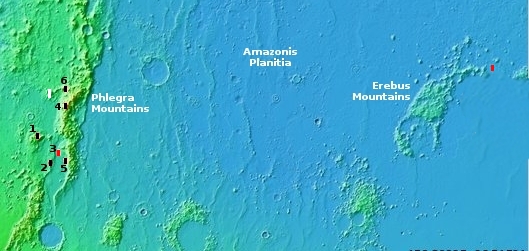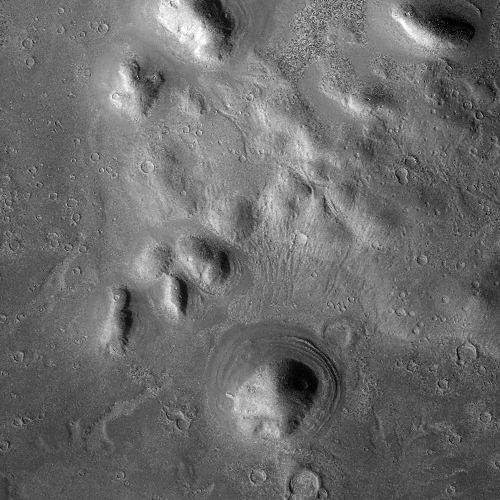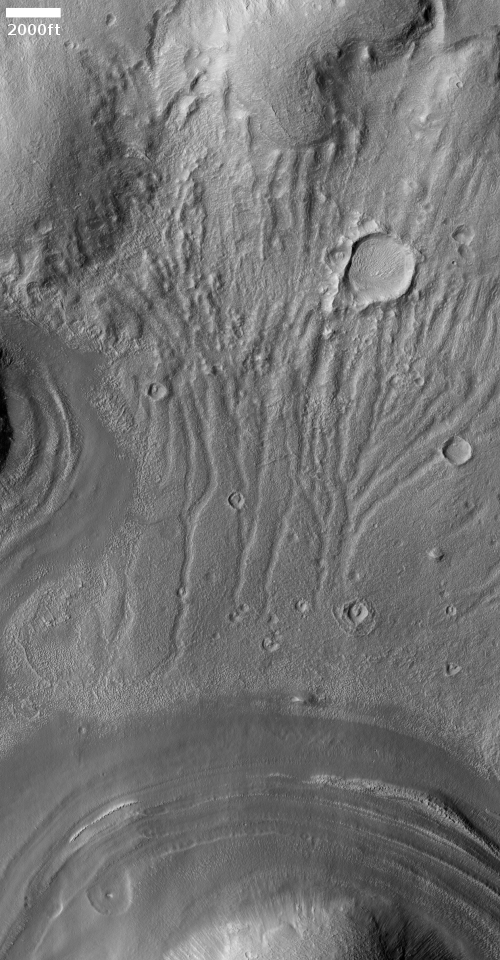The icy Phlegra Mountains on Mars

Cool image time! The Phlegra Mountains on Mars are probably the iciest mountains on the red planet, something I noted previously in an April 2020 essay, highlighting a half dozen images from the high resolution camera on Mars Reconnaissance Orbiter (MRO) that showed that iciness. As I stated:
Here practically every photograph taken by any orbiter appears to show immense glacial flows of some kind, with some glaciers coming down canyons and hollows [#1], some filling craters [#2], some forming wide aprons [#3] at the base of mountains and even at the mountains’ highest peaks [#4], and some filling the flats [#5] beyond the mountain foothills.
And then there are the images that show almost all these types of glaciers, plus others [#6].
The overview map above not only shows the locations of these six images in black, it also shows in red two of SpaceX’s four prime candidate landing sites for its Starship spacecraft. Note that #3 above is one of those sites.
The white rectangle in the Phlegra Mountains marks the location of today’s cool image below, taken on June 11, 2021 by MRO’S high resolution camera.
To the right are two photos, the top MRO’s context camera’s wider view, the bottom the high resolution camera’s closer view of the north slope of the most prominent peak, showing in greater detail the drainage patterns flowing down from that slope.
Like all the other images above, as well as almost any high resolution image taken of these mountains, everything about the terrain screams buried glaciers.
In the wide context camera photo, you can see that every hill or peak is surrounded by an apron of material. The hollows between the peaks also appear to have flows resembling glaciers on Earth, with the lowest points all appearing as if they are filled with this icelike material.
In the close up view below the layered look of these deposits on the two mountain slopes is very evident. These layers probably signal evidence of past Martian climate cycles, when the glaciers were fluctuating from growth to shrinkage.
All the craters in this landscape appear to have impacted a soft slush, so that their rims are subdued, their interiors are shallow, and in some cases a splash apron of material surrounds them.
The image also makes evident the braided tributaries flowing down to the north from the northern slope of the largest peak. The impression given is that at some point in the past the glacier got heated, either possibly from one or several impacts or from some underground volcanic activity, and this caused ice below the ground to suddenly liquefy and flow downward for a short distance, melting the ice as it went. Then, because liquid water cannot survive long in Mars’ thin and cold atmosphere, that liquid quickly sublimated away into gas, and the drainages faded.
Before they did so however it appears the water ran up against glacial material to the north and melted that away as well, leaving behind a rough depression. Later a larger impact occurred, creating that large very flat crater on top of the tributaries. The smaller craters nearby could be secondaries of that impact.
While these photos show us the icy nature of these mountains. they also tell us their future. Sometime in the centuries to come, when humans live on Mars, these mountains will likely see a lot of mining activity, mining not for gold or silver or copper, but water, a resource far more valuable to the early pioneers making the red planet a habitable place for humans.
On Christmas Eve 1968 three Americans became the first humans to visit another world. What they did to celebrate was unexpected and profound, and will be remembered throughout all human history. Genesis: the Story of Apollo 8, Robert Zimmerman's classic history of humanity's first journey to another world, tells that story, and it is now available as both an ebook and an audiobook, both with a foreword by Valerie Anders and a new introduction by Robert Zimmerman.
The print edition can be purchased at Amazon or from any other book seller. If you want an autographed copy the price is $60 for the hardback and $45 for the paperback, plus $8 shipping for each. Go here for purchasing details. The ebook is available everywhere for $5.99 (before discount) at amazon, or direct from my ebook publisher, ebookit. If you buy it from ebookit you don't support the big tech companies and the author gets a bigger cut much sooner.
The audiobook is also available at all these vendors, and is also free with a 30-day trial membership to Audible.
"Not simply about one mission, [Genesis] is also the history of America's quest for the moon... Zimmerman has done a masterful job of tying disparate events together into a solid account of one of America's greatest human triumphs."--San Antonio Express-News

Cool image time! The Phlegra Mountains on Mars are probably the iciest mountains on the red planet, something I noted previously in an April 2020 essay, highlighting a half dozen images from the high resolution camera on Mars Reconnaissance Orbiter (MRO) that showed that iciness. As I stated:
Here practically every photograph taken by any orbiter appears to show immense glacial flows of some kind, with some glaciers coming down canyons and hollows [#1], some filling craters [#2], some forming wide aprons [#3] at the base of mountains and even at the mountains’ highest peaks [#4], and some filling the flats [#5] beyond the mountain foothills.
And then there are the images that show almost all these types of glaciers, plus others [#6].
The overview map above not only shows the locations of these six images in black, it also shows in red two of SpaceX’s four prime candidate landing sites for its Starship spacecraft. Note that #3 above is one of those sites.
The white rectangle in the Phlegra Mountains marks the location of today’s cool image below, taken on June 11, 2021 by MRO’S high resolution camera.
To the right are two photos, the top MRO’s context camera’s wider view, the bottom the high resolution camera’s closer view of the north slope of the most prominent peak, showing in greater detail the drainage patterns flowing down from that slope.
Like all the other images above, as well as almost any high resolution image taken of these mountains, everything about the terrain screams buried glaciers.
In the wide context camera photo, you can see that every hill or peak is surrounded by an apron of material. The hollows between the peaks also appear to have flows resembling glaciers on Earth, with the lowest points all appearing as if they are filled with this icelike material.
In the close up view below the layered look of these deposits on the two mountain slopes is very evident. These layers probably signal evidence of past Martian climate cycles, when the glaciers were fluctuating from growth to shrinkage.
All the craters in this landscape appear to have impacted a soft slush, so that their rims are subdued, their interiors are shallow, and in some cases a splash apron of material surrounds them.
The image also makes evident the braided tributaries flowing down to the north from the northern slope of the largest peak. The impression given is that at some point in the past the glacier got heated, either possibly from one or several impacts or from some underground volcanic activity, and this caused ice below the ground to suddenly liquefy and flow downward for a short distance, melting the ice as it went. Then, because liquid water cannot survive long in Mars’ thin and cold atmosphere, that liquid quickly sublimated away into gas, and the drainages faded.
Before they did so however it appears the water ran up against glacial material to the north and melted that away as well, leaving behind a rough depression. Later a larger impact occurred, creating that large very flat crater on top of the tributaries. The smaller craters nearby could be secondaries of that impact.
While these photos show us the icy nature of these mountains. they also tell us their future. Sometime in the centuries to come, when humans live on Mars, these mountains will likely see a lot of mining activity, mining not for gold or silver or copper, but water, a resource far more valuable to the early pioneers making the red planet a habitable place for humans.
On Christmas Eve 1968 three Americans became the first humans to visit another world. What they did to celebrate was unexpected and profound, and will be remembered throughout all human history. Genesis: the Story of Apollo 8, Robert Zimmerman's classic history of humanity's first journey to another world, tells that story, and it is now available as both an ebook and an audiobook, both with a foreword by Valerie Anders and a new introduction by Robert Zimmerman.
The print edition can be purchased at Amazon or from any other book seller. If you want an autographed copy the price is $60 for the hardback and $45 for the paperback, plus $8 shipping for each. Go here for purchasing details. The ebook is available everywhere for $5.99 (before discount) at amazon, or direct from my ebook publisher, ebookit. If you buy it from ebookit you don't support the big tech companies and the author gets a bigger cut much sooner.
The audiobook is also available at all these vendors, and is also free with a 30-day trial membership to Audible.
"Not simply about one mission, [Genesis] is also the history of America's quest for the moon... Zimmerman has done a masterful job of tying disparate events together into a solid account of one of America's greatest human triumphs."--San Antonio Express-News



